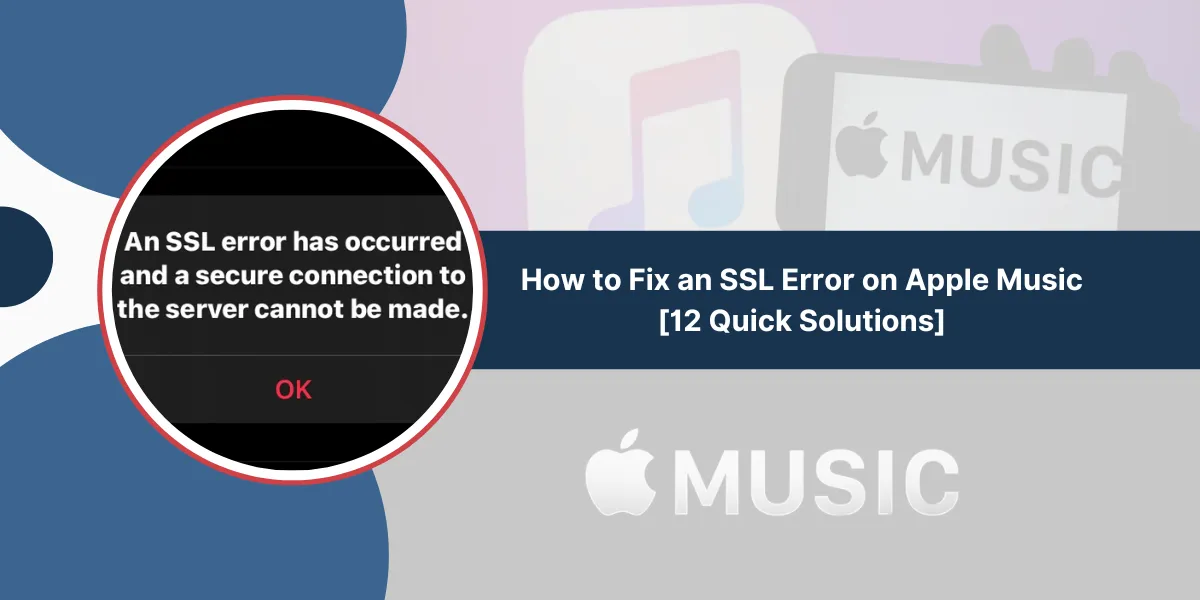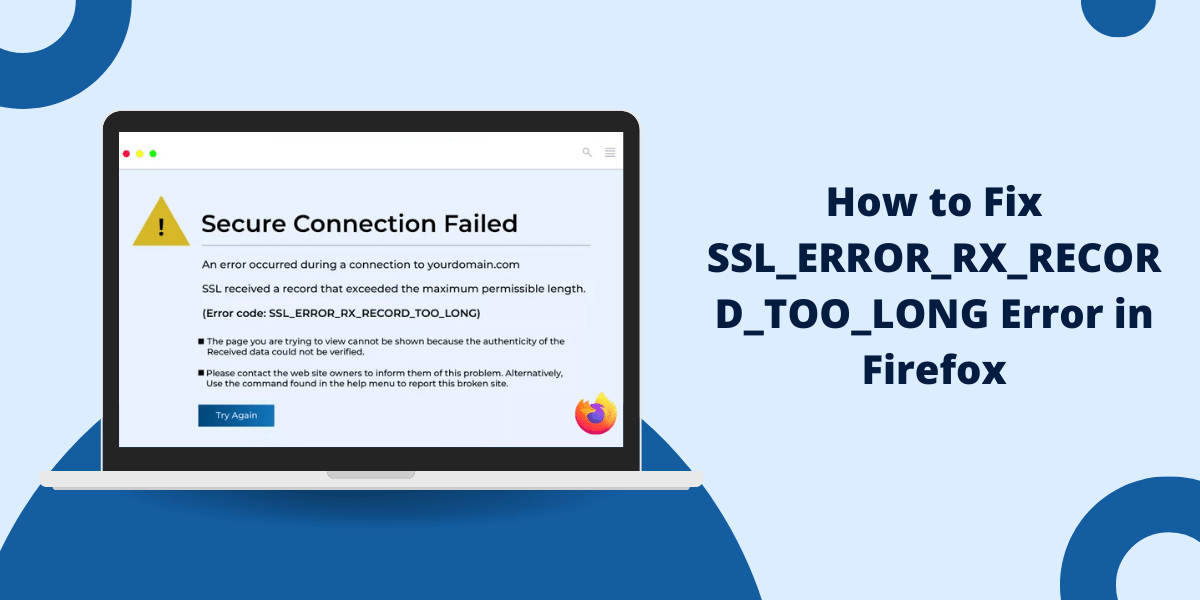SSL errors on Apple Music can completely disrupt your music streaming experience, leaving you staring at frustrating messages like “SSL Error Occurred”, “Secure Connection Failed”, or “Cannot Verify Server Identity.” These errors indicate a breakdown in the secure communication between your device and Apple’s servers, preventing you from accessing your favorite songs and playlists.
What Is an SSL Error for Apple Music?
An SSL (Secure Sockets Layer) error means your device cannot establish a secure connection with Apple Music’s servers. This security layer encrypts data to protect your privacy, but when it fails, you may see messages like:
- “SSL Error: The connection could not be established securely.”
- “Cannot verify server identity.”
- “Apple Music won’t load due to SSL issues.”
Why Does This Happen?
Common causes include:
- Outdated iOS/macOS software
- Incorrect device date & time settings
- Network restrictions (firewalls, VPNs, proxies)
- Corrupt DNS or cache files
- Apple server outages
Common SSL Error Messages in Apple Music
You might encounter variations like:
- SSL Error: Secure connection failed
- Cannot establish secure connection to Apple Music
- The identity of the server cannot be verified
- SSL handshake failed
- Certificate verification error
12 Proven Fixes for Apple Music SSL Errors
- Verify Apple Music Server Status
- Update Your Device’s Operating System
- Correct Date & Time Settings
- Reset Network Settings
- Disable VPN and Proxy Connections
- Clear DNS Cache
- Change DNS Servers
- Reinstall Apple Music App
- Reset All Settings (iOS)
- Check Firewall Settings (Mac)
- Try a Different Network
- Create a New Network Location (Mac)
Fix 1: Verify Apple Music Server Status
Before troubleshooting your device:
- Visit Apple’s System Status page
- Look for any yellow or red indicators next to:
- Apple Music
- iTunes Store
- iCloud Account & Sign In
- If services are down, wait for Apple to resolve the issue
Pro Tip: Check third-party sites like Downdetector for user-reported outages.
Fix 2: Update Your Device’s Operating System
Outdated software often causes SSL handshake failures.
For iOS/iPadOS:
- Go to Settings > General > Software Update
- Download and install any available updates
- Restart your device after updating
For macOS:
- Open System Preferences > Software Update
- Install all available updates
- Consider upgrading to the latest macOS version if you’re several releases behind
Fix 3: Correct Date & Time Settings
Incorrect system time prevents proper SSL certificate validation.
iOS/iPadOS:
- Open Settings > General > Date & Time
- Enable Set Automatically
- Ensure the correct time zone is selected
macOS:
- Go to System Preferences > Date & Time
- Check Set date and time automatically
- Click the lock icon to make changes if needed
Windows (for iTunes users):
- Right-click the clock in the taskbar
- Select Adjust date/time
- Enable Set time automatically
Fix 4: Reset Network Settings
Corrupt network configurations are a common SSL error cause.
For iPhone/iPad:
- Go to Settings > General > Transfer or Reset [Device]
- Tap Reset > Reset Network Settings
- Enter your passcode if prompted
- Wait for the device to restart
For Mac:
- Open System Preferences > Network
- Select your active connection (Wi-Fi/Ethernet)
- Click the gear icon > Make Service Inactive
- Then click Apply
- Reactivate the service and reconnect
Fix 5: Disable VPN and Proxy Connections
Security tools can interfere with SSL validation.
To disable VPN:
- Open Settings > General > VPN & Device Management
- Toggle off any active VPN connections
To disable proxy:
- Go to Settings > Wi-Fi
- Tap the (i) icon next to your network
- Scroll to HTTP Proxy
- Select Off
For macOS:
- Open System Preferences > Network
- Select your connection > Advanced > Proxies
- Uncheck all proxy options
- Click OK > Apply
Fix 6: Clear DNS Cache
Stale DNS records can cause SSL issues.
On Mac:
- Open Terminal
- Enter: sudo dscacheutil -flushcache; sudo killall -HUP mDNSResponder
- Enter your admin password when prompted
On Windows (for iTunes):
- Open Command Prompt as Administrator
- Type: ipconfig /flushdns
- Press Enter
Fix 7: Change DNS Servers
Try using public DNS servers like Google’s or Cloudflare’s.
iOS/iPadOS:
- Go to Settings > Wi-Fi
- Tap the (i) next to your network
- Select Configure DNS > Manual
- Add servers:
- 8.8.8.8 (Google)
- 1.1.1.1 (Cloudflare)
- Tap Save
macOS:
- System Preferences > Network
- Select connection > Advanced > DNS
- Replace existing servers with:
- 8.8.8.8
- 8.8.4.4
- Click OK > Apply
Fix 8: Reinstall Apple Music App
Corrupt app files might be causing the issue.
For iOS:
- Long-press the Apple Music app icon
- Select Remove App > Delete App
- Go to App Store and reinstall
For Mac:
- Open Finder > Applications
- Drag Music.app to Trash
- Empty Trash
- Reinstall from App Store
Fix 9: Reset All Settings (iOS)
This preserves data while resetting configurations.
- Go to Settings > General > Transfer or Reset iPhone
- Tap Reset > Reset All Settings
- Enter passcode if prompted
- Wait for the process to complete
Fix 10: Check Firewall Settings (Mac)
Overly restrictive firewalls can block Apple Music.
- Open System Preferences > Security & Privacy > Firewall
- Click the lock to make changes
- Either:
- Temporarily disable firewall, or
- Click Firewall Options and ensure Apple Music is allowed
Fix 11: Try a Different Network
Network-level restrictions might be the culprit.
- Switch from Wi-Fi to cellular data (or vice versa)
- Try a different Wi-Fi network
- Test with a mobile hotspot
- Restart your router/modem
Fix 12: Create a New Network Location (Mac)
This establishes fresh network configurations.
- System Preferences > Network
- Click the Location dropdown
- Select Edit Locations > +
- Name it “Apple Music Fix”
- Click Done > Apply
Advanced Troubleshooting
1. Inspect SSL Certificates (Mac)
- Open Keychain Access
- Search for “Apple” in certificates
- Verify none are expired or marked as untrusted
2. Monitor Network Traffic
Use tools like Wireshark to analyze SSL handshake failures.
3. Test in Safe Mode (Mac)
Boot in Safe Mode to check for software conflicts.
Final Thoughts
SSL errors in Apple Music can stem from various causes, but methodical troubleshooting typically resolves them. Start with basic fixes like updating software and checking network settings before moving to advanced solutions. Remember that some issues may require patience if they’re server-side.
Frequently Asked Questions (FAQs)
Why does Apple Music show an SSL certificate error?
SSL certificate errors on Apple Music occur due to incorrect date and time settings on your device. The error can also appear because of outdated iOS versions or network security conflicts.
How do I clear SSL certificate on iPhone?
Users can clear SSL certificates on iPhone by going to Settings > General > Profiles. Delete any suspicious profiles. Users should restart their device after removing certificates.
What does SSL error mean on Apple devices?
An SSL error indicates a security protocol issue between your device and Apple’s servers. This error prevents secure data transmission and blocks access to Apple Music services.
How do I fix Apple Music not loading?
Users should first check their internet connection. Then, sign out of Apple ID and sign back in. Finally, update the iOS system to the latest version.
Why is my Apple Music showing a connection error?
Connection errors appear due to weak internet signals, server maintenance, or app cache issues. Users can fix this by resetting network settings or reinstalling the Apple Music app.
How do I reset Apple Music settings?
Open iPhone Settings and tap on Music. Select “Clear Play History” and toggle off/on iCloud Music Library. Restart the Apple Music app to apply changes.

Priya Mervana
 Verified Web Security Experts
Verified Web Security Experts
Priya Mervana is working at SSLInsights.com as a web security expert with over 10 years of experience writing about encryption, SSL certificates, and online privacy. She aims to make complex security topics easily understandable for everyday internet users.



